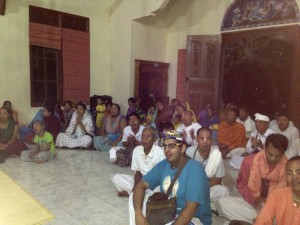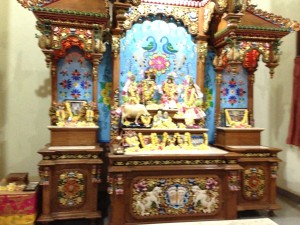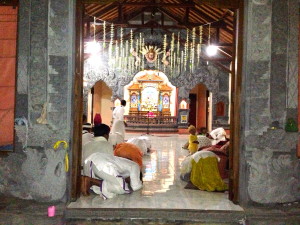Verse 4.12:
Men in this world desire success in fruitive activities, and therefore they worship the demigods. Quickly, of course, men get results from fruitive work in this world.One of the good (bad?!) things about bhakti yoga is that it forces you to really face your intentions and desires. Not just the superficial ones, but the deep one's that we try to hide and forget about.It's open, non-sectarian and there's something in it for everyone. It's an ideal process because it teaches us how to be successful as persons living in this material world, and for those who are interested, the process by which we can successfully reconnect with our true selves and find eternal happiness.
But...for those who are interested in the latter, bhakti yoga is about work. The best analogy that comes to mind is that of cleaning a really messy room. At the outset there needs to be some faith that cleaning the room will actually help you. Mustering up some enthusiasm (and determination!), you get started and in the beginning may start to experience a sense of accomplishment. But as time progresses (and if you're anything like me), you realize that you had no clue what you were getting yourself into!
That's because as you stand surrounded by clothes and other objects lay strewn about you, shaking your head in disbelief at the amount of things you've accumulated, it becomes clear.
There's a lot of junk that just needs to be thrown out.That's exactly what the practice of bhakti yoga reveals: we have a lot of junk that surrounds our heart and prevents us from experiencing true happiness.Because we invest our time and energy in that junk, we get side-tracked and forget that happiness actually lies within.
Distilling this verse down, it's stating that if we really want to accumulate more junk, then there's a certain place to go to ask for such blessings. Again, the Gita is not stating that it is bad, per say, but is giving the process (Remember! It's a handbook for both material and spiritual success) to achieve material success.
However, staying true to it's purpose, the Gita does not recommend this path. For the sake of completeness, it is presented and for those who choose that path it gives the formula.
But, if we are truly interested in cleaning our room, it will remain in our consciousness that going out and buying more things will be counter-productive. Similarly, for those who are genuinely interested in attaining permanent happiness and peace, this path isn't the one for them.
The only question you have to ask is - what do you want? Do you really want to clean the room of your heart or are you interested in just accumulating more?





 Just as last year - for the pleasure of Srila Prabhupada - we prepared a range of workshops and lunchtime activities. They showcased the rich culture of India and gave students a taste of what our local Hare Krishna temple has to offer.
Just as last year - for the pleasure of Srila Prabhupada - we prepared a range of workshops and lunchtime activities. They showcased the rich culture of India and gave students a taste of what our local Hare Krishna temple has to offer. 



 With enthusiasm citizens embraced the idea that if you pull the chariot of the rope, you can attract into your life the well-being and prosperity.
With enthusiasm citizens embraced the idea that if you pull the chariot of the rope, you can attract into your life the well-being and prosperity. 




 Today, Sri Sri Radha-Madhava Mandir has become an extremely popular destination for Manilans, with over a thousand people filling the temple to bursting point on major festivals.
Today, Sri Sri Radha-Madhava Mandir has become an extremely popular destination for Manilans, with over a thousand people filling the temple to bursting point on major festivals.  Damodar Hari Kansal's hilarious gurukuli skit at the Kulimela this summer in Germany. It was a great way to represent the 2013 Euro bustour at the kulimela and it was a pretty hilarious show too.
Damodar Hari Kansal's hilarious gurukuli skit at the Kulimela this summer in Germany. It was a great way to represent the 2013 Euro bustour at the kulimela and it was a pretty hilarious show too.  123 pics: ISKCON Laguna (Philippines)
123 pics: ISKCON Laguna (Philippines) 